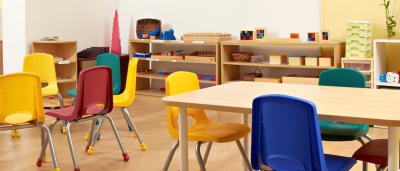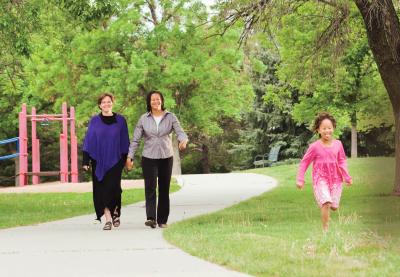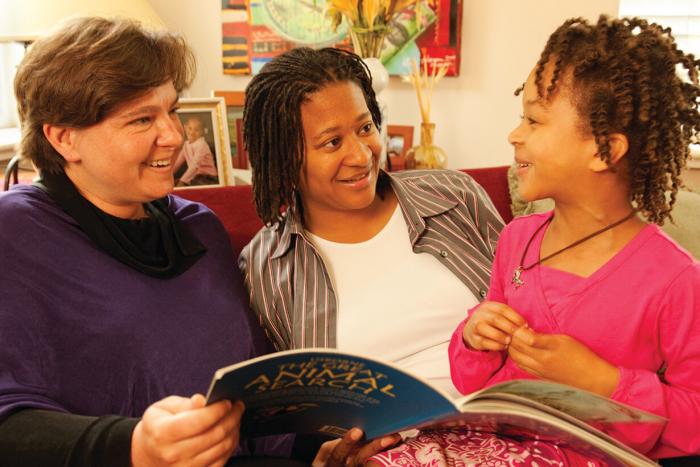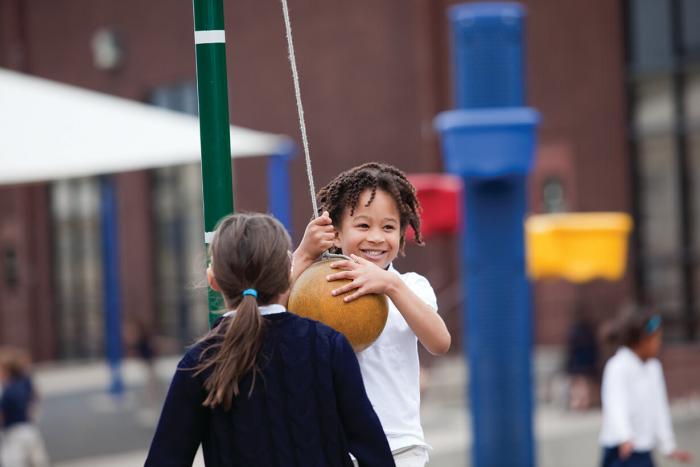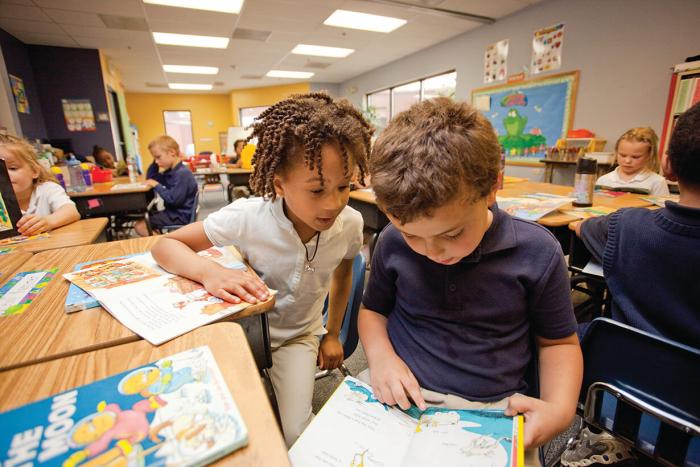The butcher-paper display outside the classroom was as tall as me and twice as wide, a sweeping visual reminder of one of the school’s goals: Move 10% of students from unsatisfactory to proficient. Crafted with construction paper and sparkly glue that caked around the edges, a colorful bar chart showed just how far students had to go: halfway through the year, only 6% of them met the skill standard, “Count by 5s.”
Inside the classroom, the teacher was explaining how fall turns to winter. Mind you, this was January in Denver, Colorado. She then asked the students to draw a picture of seasons changing. “If you know how, write your name at the top of your paper,” she instructed. The students nodded and, almost in unison, reached into the bowls of crayons at the center of their tables. Squabbles erupted here and there, as tiny hands battled for the most highly coveted colors, “bear hug brown,” forest green, chestnut red and “unmellow yellow.”
I thanked the teacher for allowing me to observe and ducked out the door. A couple of paces down the hall, I nearly tripped over two little feet attached to a brown-skinned third grader sitting on the floor. She had a test-prep workbook propped up in her lap and was teary eyed, looking at the adult tutor next to her.
This school was just one of many stops in my family’s journey to find the perfect kindergarten classroom for our little Zoe. In the course of our journey, we talked with our daughter about what she wanted in a school (“friends,” “candy,” “no long naps”); we asked our friends and neighbors — and educators at Zoe’s preschool — for their recommendations, and investigated each of them; we downloaded and printed reams of information from the web about the Denver Public Schools; we did site visits; we took private tours; we spoke with principals; we chatted up teachers and media specialists; we harassed admissions coordinators; and we filled out form after form after form — choice forms!, lottery forms!, enrollment forms!, full-day kindergarten declaration forms!, guardian agreement forms!
It took work and it took patience, but more than that, our journey to kindergarten forced us to interrogate our values and the meaning of race, class and privilege in our lives and in our community.
Family Values
We — the Smith-Holladays — are an interracial family. My spouse, Catherine, is African American. So is our daughter. Zoe would describe me as “You’re-a-pee’in.” (She’s still at the stage where any and all potty jokes are hysterical.)
We’re the kind of interracial family where race matters. We talk about race openly and often, and, from the get-go, Catherine and I have shared a primary parenting goal: raise up a healthy, happy, think-for-herself African American woman who has a strong sense of identity and community. So when the time came to find a kindergarten classroom, we sought to translate that goal into a vision for Zoe’s schooling. It seemed simple enough. We wanted: 1) a public school that is 2) racially, culturally and linguistically diverse and inclusive and 3) academically rigorous.
Yet we knew this vision was anything but simple. Catherine and I both work in education, and we’re intimately familiar with the statistics indicating that this dream school of ours could prove a pipe dream. Schools are more segregated today than they were in 1968, and the achievement gap between black and brown and white children remains cavernous in Denver, in Colorado and throughout the country.
We expected a rough road, to be sure, but it turned out to be difficult in ways we didn’t anticipate.
For example, what did Catherine and I really mean by a “public school”? Did we mean “real” public schools, or were we also talking about charters and magnets? If we considered charters and magnets, wouldn’t we be complicit in the escalating abandonment of traditional schools? Oh wait — we’d already become complicit in that. After discovering our neighborhood school didn’t meet our three criteria, Catherine and I had already agreed to use Denver’s “choice” system.
And what did we really mean by a “diverse and inclusive” school? If a school has a large ELL population, but those students are segregated for half of the day, the school is diverse — but is it inclusive? How would Zoe ever get to know her peers, or learn from them? What about the lunchrooms and playgrounds we observed, where children largely self-segregated by race, ethnicity and language — and gender, too? What lessons about diversity would Zoe learn in these environments?
And what did Catherine and I mean by “academically rigorous”? Certainly, we weren’t going to judge schools solely on their test score ratings. (Were we?) How should we feel about the use of scripted curriculum? Would our daughter be well served by a teacher who’s struggling to get to page 105 by the last bell on a particular Friday? What about the widespread embrace of ability grouping? (We know what can happen to black children in classrooms where students are grouped by perceived “performance.”) And what about the fees that sometimes appear if you want your child exposed to the arts or other “extracurricular” content? Or the tuition our public schools charge for full-day kindergarten? Could Zoe — could any child — receive a truly rigorous education without these things?
The “P-Words”
Amidst all of this, we struggled with the constant knowledge that this search of ours also was the ultimate exercise of our privilege — our professional privilege and our class privilege. At the time, Catherine and I both had jobs that allowed us to attend open houses and tours, which the schools almost universally scheduled during traditional workday hours. Even with the flexibility our jobs allowed, we couldn’t always attend as a couple — meetings and so forth get scheduled and can’t be moved — but because each of us only had one job, we had nights and weekends to share and discuss what we’d seen and heard on our solo adventures.
Pretty quickly, reality set in: even if we found the “perfect” kindergarten classroom for Zoe, she probably wouldn’t get in. Like so many others across the country, our city’s “choice” system is largely a false promise. At the open house for a school that’s also home to a “gifted and talented” program, for example, scores of families showed up to learn about the two “choice” kindergarten slots likely to be available in the Fall. The lottery system for charters isn’t much better; the charter school that sits literally at the end of our street received hundreds of applications for its 24 slots the prior year.
These realities meant we needed a back-up plan, and that meant leveraging our class privilege to consider the other “p-word” — private schools. Catherine found a truly great one with an extremely diverse student body, a campus that could rival even the most pristine university in terms of its lush grounds and resources and a longstanding record of academic excellence. And all this could be Zoe’s for a mere $12,000 a year.
The private school episode was the only time Catherine and I were not on the same page. It took me more than a week to return numerous phone calls from the school’s admissions director. By the time I did, she had moved Zoe to the waiting list. Catherine was frustrated, and rightly so: I’d placed my own discomfort about sending our daughter to an elite private school ahead of what we needed — and what Catherine had labored to find — for Zoe. It didn’t help that, despite my squeamishness about private schools, I myself am a product of one. Because of my actions, we didn’t have a back-up plan when the rejection letters from public schools inevitably began to arrive in our mailbox.
Shades of Gray
The call came on a Friday. The admissions director at our top pick among the charter schools was on the phone. A spot had opened up, and it was Zoe’s if we still wanted it.
We love this school because its vision of education so closely mirrors our own. Its mission statement reads, “[we aim] to foster a diverse and equitable community of youth and adults striving together for academic, personal, and civic excellence.” But what really drew us in was its open house, held on a Saturday.
Black, white and brown students, each dressed in khakis and a golf shirt, greeted us at the door. They then proceeded to run the open house. The students shared their “likes” about the school — “it’s fun,” “it’s challenging,” “the teachers care about us,” “we get to know everyone,” “it’s diverse” — and their dislikes — “uniforms,” “no grass on the playground,” “the building.” (The school is in a warehouse.) As parents, we couldn’t help but admire a school that empowers children to stand up in a room full of adults and speak their minds, even if it means airing some dirty laundry here and there.
By the time the principal and teachers spoke — to share, among other things, that the school is rated “high” performing (just shy of the district’s best rating of “excellent”), that it uses strict ability grouping (sigh), and that they are working purposefully to close their achievement gap — Catherine and I already knew this was a learning community our family could join enthusiastically.
This fall, Zoe will be sitting in a kindergarten classroom wearing her own pair of khakis and a golf shirt, and we’ll find out whether she likes this school as much as her moms do —whether it’s the right place for her, whether she will thrive there. We hope so, and, regardless, Catherine and I won’t forget the discoveries we made on the way to kindergarten.
The journey forced us to navigate the meaning of race, class and privilege in our family and in our community, sometimes in profoundly uncomfortable ways. There were no clear solutions or right answers, perhaps because none exist. As feminist Audre Lorde told the Denver Quarterly nearly 30 years ago, “Only by learning to live in harmony with your contradictions can you keep it all afloat.” Although we always aim for more than “staying afloat,” sometimes staying true means being willing to dabble in shades of gray.
